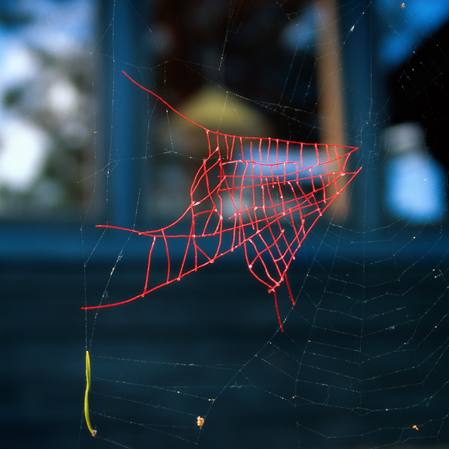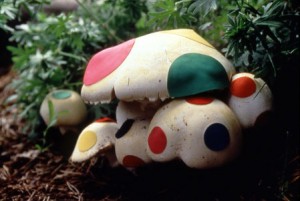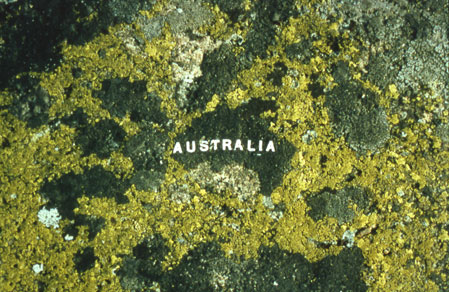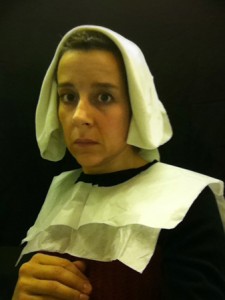I’m very interested in situations where there are limits and boundaries to what’s possible and how you find your way around those obstacles, how you think on your feet. How you make something out of nothing… — Nina Katchadourian
All year in Lebanon, I’ve been spending a lot of time in nature. And whenever I’m swimming with the turtles in the sea or taking a hike through the cedars, I find myself thinking of the witty, playful and endearing eco-art of my friend Nina.
I first met Nina Katchadourian when we were members of the same Javenese gamelan ensemble at Brown. Indonesian orchestras tend to attract curious and creative souls, and every time we stopped for a break from playing our meditative music, I enjoyed asking Nina all about her latest artistic endeavors–many of which were inspired by her travels abroad, and her extended time spent in nature.
Whether she’s mending spiderwebs with red sewing thread (above), or using a bicycle tire patching kit to patch up mushrooms with small tears on the caps, Nina’s playful (and uninvited) collaborations with nature have encouraged me to re-conceptualize my own relationship to the natural world–to find beauty and possibility in overlooked natural designs–and even destruction and decay…
For her series Moss Maps (above), Nina found and photographed patches of lichen in the shape of islands and continents, when spending the summer in the Finnish archipelago where her family has a home. Putting rub-on letters on the lichen instantly transformed this granite rock into a rearranged organic atlas. In the goofy piece below, Nina critiques her own “use” of nature by having carefully arranged caterpillars deliver a message of their own.
It wasn’t until I got to Beirut that I learned of her family’s long connection to Lebanon–which she mentions in the piece below. Part of Nina’s interest in language, translation, and miscommunication derives being the daughter of multilingual migrants. To explore the arduous and often absurd process of assimilation, Nina enlisted the help of her parents to create “Accent Elimination”–in which a dialect coach tries to neutralize her parents’ accents, while Nina simultaneously struggles to acquire them.
Nina’s piece “Natural Car Alarms”, which was profiled on NPR, involves three cars rigged with modified car alarms. The six-tone siren has been replaced with bird calls.
The idea for the project was in fact the result of a misunderstanding. I heard a bird in the jungles of Trinidad that I mistook for a car alarm.
— Nina Katchadourian
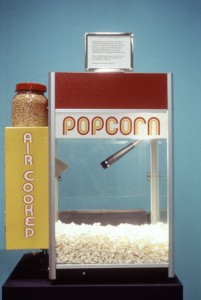
Talking Popcorn Concession stand popcorn machine, microphone, laptop with custom-written Morse Code program, printed paper bags, dimensions variable, 2001
Nina’s interest in the translation of sound into recognizable speech appears in her sound sculpture piece Talking Popcorn (left)–which contains a hidden computer to “translate” the sound of corn popping into Morse Code. A computer-generated voice gives a simultaneous spoken translation. Surprisingly, the first word ever produced by this machine was: WE.
Much of my subject matter comes from the mundane everyday. I’m always trying to look at the things we are overlooking and underestimating in terms of their interest or value… — Nina
As a world traveler, I’m in love with her Seat Assignment series–for which she creates photographs and video in flight using only the most basic of materials on a plane–a camera phone, pretzels, magazines, and even toilet paper. For example, her Lavatory Self-Portraits in the Flemish Style (below) were created by locking herself in the lavatory of a plane to take self-portraits on her phone–while dressed with toilet paper in the style of fifteenth century Flemish portraiture.
Nina’s work constantly reminds me that there is value, beauty, humor and creative possibility in even the most mundane moments and objects. Watching her engage in playful and yet profound dialogue with the nuances of nature and daily life that often go unnoticed, I find myself wanting to cultivate a more creative, awakened, and dynamic relationship with the world, which is always ready for compassionate collaboration–invited or not.To see more of Nina’s work, please go here.
